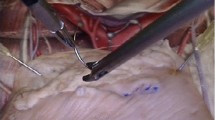Abstract
Background
The assessment of technical skills should provide objective feedback and judge suitability of progress during training. The aim of this study was to validate two objective assessment techniques for laparoscopic suturing and demonstrate a correlation between them.
Methods
Six experts, seven surgeons skilled in laparoscopic suturing, and 13 with no laparoscopic suturing skills were asked to place two or three intracorporeal sutures on a synthetic suture pad. The latter group was given video-based instructions prior to the execution of the sutures. Ergonomic conditions were standardized for all subjects. The procedures were recorded on videotape and two blinded observers rated the first suture of each subject on a 29-point checklist. A motion analysis system, Imperial College Surgical Assessment Device, was used to assess psychomotor skills.
Results
There was a significant difference in the time taken (p = 0.000) and total path length (p = 0.000) per suture across the groups. There were also a significant difference in the total checklist score (p = 0.000) and its individual categories. The was a strong correlation between the total path length and the total checklist score (coefficient, 0.78; p < 0.001).
Conclusions
A combination of the motion analysis system and the checklist would make the process of formative feedback during the learning of intracorporeal suturing objective and comprehensive.







Similar content being viewed by others
References
B Cagir M Rangraj L Maffuci BL Herz (1994) ArticleTitleThe learning curve for laparoscopic cholecystectomy J Laparoendosc Surg 4 419–427 Occurrence Handle7881146
JY Chung JM Sackier (1998) ArticleTitleA method of objectively evaluating improvements in laparoscopic skills Surg Endosc 12 1111–1116 Occurrence Handle10.1007/s004649900795 Occurrence Handle9716762
A Cuschieri N Francis J Crosby GB Hanna (2001) ArticleTitleWhat do master surgeons think of surgical competence and revalidation? Am J Surg 182 110–116 Occurrence Handle10.1016/S0002-9610(01)00667-5 Occurrence Handle11574079
DJ Deziel KW Millikan SG Economou A Doolas ST Ko MC Airan (1993) ArticleTitleComplications of laparoscopic cholecystectomy: a national survey of 4,292 hospitals and an analysis of 77,604 cases Am J Surg 165 9–14 Occurrence Handle8418705
TR Eubanks RH Clements D Pohl N Williams DC Schaad S Horgan et al. (1999) ArticleTitleAn objective scoring system for laparoscopic cholecystectomy J Am Coll Surg 189 566–574 Occurrence Handle10.1016/S1072-7515(99)00218-5 Occurrence Handle10589593
JW Fleshman RD Fry EH Birnbaum IJ Kodner (1996) ArticleTitleLaparoscopic-assisted and minilaparotomy approaches to colorectal diseases are similar in early outcome Dis Colon Rectum 39 15–22 Occurrence Handle10.1007/BF02048262 Occurrence Handle8601351
AG Gallagher RM Satava (2002) ArticleTitleVirtual reality as a metric for the assessment of laparoscopic psychomotor skills. Learning curves and reliability measures Surg Endosc 16 1746–1752 Occurrence Handle10.1007/s00464-001-8215-6 Occurrence Handle12140641
JA Kopta (1971) ArticleTitleAn approach to the evaluation of operative skills Surgery 70 297–303 Occurrence Handle5560189
M Lekawa SJ Shapiro LA Gordon J Rothbart JR Hiatt (1995) ArticleTitleThe laparoscopic learning curve Surg Laparosc Endosc 5 455–458 Occurrence Handle8611992
T Mori N Hatano S Maruyama Y Atomi (1998) ArticleTitleSignificance of “hands-on training” in laparoscopic surgery Surg Endosc 12 256–260 Occurrence Handle10.1007/s004649900646 Occurrence Handle9502707
JH Peters EC Ellison JT Innes JL Liss KE Nichols JM Lomano et al. (1991) ArticleTitleSafety and efficacy of laparoscopic cholecystectomy. A prospective analysis of 100 initial patients Ann Surg 213 3–12 Occurrence Handle1824674
G Regehr H MacRae RK Reznick D Szalay (1998) ArticleTitleComparing the psychometric properties of checklists and global rating scales for assessing performance on an OSCE-format examination Acad Med 73 993–997 Occurrence Handle9759104
RK Reznick (1993) ArticleTitleTeaching and testing technical skills Am J Surg 165 358–361 Occurrence Handle8447543
JC Rosser LE Rosser RS Savalgi (1997) ArticleTitleSkill acquisition and assessment for laparoscopic surgery Arch Surg 132 200–204 Occurrence Handle9041927
JC Rosser SuffixJr LE Rosser RS Savalgi (1998) ArticleTitleObjective evaluation of a laparoscopic surgical skill program for residents and senior surgeons Arch Surg 133 657–661 Occurrence Handle10.1001/archsurg.133.6.657 Occurrence Handle9637467
CM Royston MR Lansdown WA Brough (1994) ArticleTitleTeaching laparoscopic surgery: the need for guidelines Br Med J 308 1023–1025
AJ Simons GJ Anthone AE Ortega M Franklin J Fleshman WP Geis et al. (1995) ArticleTitleLaparoscopic-assisted colectomy learning curve Dis Colon Rectum 38 600–603 Occurrence Handle10.1007/BF02054118 Occurrence Handle7774470
CD Smith TM Farrell SS McNatt RE Metreveli (2001) ArticleTitleAssessing laparoscopic manipulative skills Am J Surg 181 547–550 Occurrence Handle10.1016/S0002-9610(01)00639-0 Occurrence Handle11513783
SG Smith J Torkington TJ Brown NJ Taffinder A Darzi (2002) ArticleTitleMotion analysis Surg Endosc 16 640–645 Occurrence Handle10.1007/s004640080081 Occurrence Handle11972205
FC Spencer FC Spencer (1978) ArticleTitleTeaching and measuring surgical techniques—the technical evaluation of competence Bull Am Coll Surgeons 63 9–12
N Taffinder S Smith J Mair R Russell A Darzi (1999) ArticleTitleCan a computer measure surgical precision? Reliability, validity and feasibility of the ICSAD Surg Endosc 13 IssueIDsuppl 1 81
J Watts WB Feldman (1985) Assessment of technical skills VR Neufeld GR Norman (Eds) Assessing clinical competence Springer New York 259–274
Author information
Authors and Affiliations
Corresponding author
Rights and permissions
About this article
Cite this article
Moorthy, K., Munz, Y., Dosis, A. et al. Bimodal assessment of laparoscopic suturing skills: Construct and concurrent validity. Surg Endosc 18, 1608–1612 (2004). https://doi.org/10.1007/s00464-003-9312-5
Received:
Accepted:
Published:
Issue Date:
DOI: https://doi.org/10.1007/s00464-003-9312-5




